Synthesis and Property Examination of Er2FeSbO7/BiTiSbO6 Heterojunction Composite Catalyst and Light-Catalyzed Retrogradation of Enrofloxacin in Pharmaceutical Waste Water under Visible Light Irradiation
Abstract
:1. Introduction
2. Result and Discussion
2.1. X-ray Diffractometer (XRD) Analysis
2.2. UV-Vis Diffuse Reflectance Spectra
2.3. Property Characterization of Er2FeSbO7/BiTiSbO6 Heterojunction Photocatalyst
2.4. Photocatalytic Activity
2.5. Possible Degradation Mechanism Analysis
3. Experimental Section
3.1. Materials and Reagents
3.2. Preparation Method of Er2FeSbO7
3.3. Preparation Method of BiTiSbO6
3.4. Synthesis of N-Doping TiO2
3.5. Synthesis of Er2FeSbO7/BiTiSbO6 Heterojunction Photocatalyst
3.6. Characterizations
3.7. Photoelectrochemical Experiments
3.8. Experimental Setup and Procedure
4. Conclusions
Supplementary Materials
Author Contributions
Funding
Institutional Review Board Statement
Informed Consent Statement
Data Availability Statement
Conflicts of Interest
References
- Du, C.; Zhang, Z.; Yu, G.; Wu, H.; Chen, H.; Zhou, L.; Zhang, Y.; Su, Y.; Tan, S.; Yang, L.; et al. A review of metal organic framework (MOFs)-based materials for antibiotics removal via adsorption and photocatalysis. Chemosphere 2021, 272, 129501. [Google Scholar] [CrossRef]
- He, X.; Kai, T.; Ding, P. Heterojunction photocatalysts for degradation of the tetracycline antibiotic: A review. Environ. Chem. Lett. 2021, 19, 4563–4601. [Google Scholar] [CrossRef] [PubMed]
- Li, D.; Zeng, S.Y.; He, M.; Gu, A.Z. Water Disinfection Byproducts Induce Antibiotic Resistance-Role of Environmental Pol-lutants in Resistance Phenomena. Environ. Sci. Technol. 2016, 50, 3193–3201. [Google Scholar] [CrossRef] [PubMed]
- Wei, H.; Hu, D.; Su, J.; Li, K.B. Intensifification of levofloxacin sono-degradation in a US/H2O2 system with Fe3O4 magnetic nanoparticles. Chin. J. Chem. Eng. 2015, 23, 296–302. [Google Scholar] [CrossRef]
- Kaviyarasu, K.; Magdalane, C.M.; Jayakumar, D.; Samson, Y.; Bashir, A.K.H.; Maaza, M.; Letsholathebe, D.; Mahmoud, A.H.; Kennedy, J. High performance of pyrochlore like Sm2Ti2O7 heterojunction photocatalyst for effificient degradation of rhodamine-B dye with waste water under visible light irradiation. J. King Saud Univ. Sci. 2020, 32, 1516–1522. [Google Scholar] [CrossRef]
- Huang, J.X.; Li, D.G.; Li, R.B.; Chen, P.; Zhang, Q.X.; Liu, H.J.; Lv, W.Y.; Liu, G.G.; Feng, Y.P. One-step synthesis of phosphorus/oxygen co-doped g-C3N4/anatase TiO2 Z-scheme photocatalyst for signifificantly enhanced visible-light photoca-talysis degradation of enrofloxacin. J. Hazard. Mater. 2020, 386, 121634. [Google Scholar] [CrossRef] [PubMed]
- Bouyarmane, H.; El Bekkali, C.; Labrag, J.; Es-Saidi, I.; Bouhnik, O.; Abdelmoumen, H.; Laghzizil, A.; Nunzi, J.M.; Robert, D. Photocatalytic degradation of emerging antibiotic pollutants in waters by TiO2/Hydroxyapatite nanocomposite materials. Surf. Interfaces 2021, 24, 101155. [Google Scholar] [CrossRef]
- Huang, P.Q.; Luan, J.F. Synthesis of a GaOOH/ZnBiTaO5 heterojunction photocatalyst with enhanced photocatalytic performance toward enrofloxacin. Rsc. Adv. 2020, 10, 4286–4292. [Google Scholar] [CrossRef] [PubMed]
- Saeed, M.; Ul Haq, A.; Muneer, M.; Ahmad, A.; Bokhari, T.H.; Sadiq, Q. Synthesis and characterization of Bi2O3 and Ag-Bi2O3 and evaluation of their photocatalytic activities towards photodegradation of crystal violet dye. Phys. Scr. 2021, 96, 125707. [Google Scholar] [CrossRef]
- Wang, W.; Zhang, J.; Chen, T.; Sun, J.; Ma, X.; Wang, Y.; Wang, J.; Xie, Z. Preparation of TiO2-modified Biochar and its Characteristics of Photo-catalysis Degradation for Enrofloxacin. Sci. Rep. 2020, 10, 6588. [Google Scholar] [CrossRef] [Green Version]
- Fink, L.; Dror, I.; Berkowitz, B. Enrofloxacin oxidative degradation facilitated by metal oxide nanoparticles. Chemosphere 2012, 86, 144–149. [Google Scholar] [CrossRef]
- Raees, A.; Jamal, M.A.; Ahmed, I.; Silanpaa, M.; Algarni, T.S. Synthesis and Characterization of CeO2/CuO Nanocomposites for Photocatalytic Degradation of Methylene Blue in Visible Light. Coatings 2021, 11, 305. [Google Scholar] [CrossRef]
- Davenport, C.L.M.; Boston, R.C.; Richardson, D.W. Effects of enrofloxacin and magnesium deficiency on matrix metabolism in equine articular cartilage. Am. J. Vet. Res. 2001, 62, 160–166. [Google Scholar] [CrossRef] [PubMed]
- Chen, Z.G.; Chen, X.L.; Di, J.; Liu, Y.L.; Yin, S.; Xia, J.X.; Li, H.M. Gra-phene-like boron nitride modified bismuth phosphate materials for boosting photocatalytic degradation of enrofloxacin. J. Colloid. Interf. Sci. 2017, 492, 51–60. [Google Scholar] [CrossRef] [PubMed]
- Guo, Q.; Zhou, C.Y.; Ma, Z.B.; Yang, X.M. Fundamentals of TiO2 Photocatalysis: Concepts, Mechanisms, and Challenges. Adv. Mater. 2019, 31, 1901997. [Google Scholar] [CrossRef] [PubMed]
- Xu, H.; Xu, Y.; Li, H.; Xia, J.; Xiong, J.; Yin, S.; Huang, C.; Wan, H. Synthesis, characterization and photocatalytic property of AgBr/BiPO4 heterojunction photocatalyst. Dalton Trans. 2012, 41, 3387–3394. [Google Scholar] [CrossRef] [PubMed]
- Nishikawa, M.; Yuto, S.; Hasegawa, T.; Shiroishi, W.; Honghao, H.; Nakabayashi, Y.; Nosaka, Y.; Saito, N. Compositing effects of CuBi2O4 on visible-light responsive photocatalysts. Mater. Sci. Semicond. Process. 2017, 57, 12–17. [Google Scholar] [CrossRef]
- Su, Y.H.; Chen, P.; Wang, F.L.; Zhang, Q.X.; Chen, T.S.; Wang, Y.F.; Yao, K.; Lv, W.Y.; Liu, G.G. Decoration of TiO2/g-C3N4 Z-scheme by carbon dots as a novel photocatalyst with improved visible-light photocatalytic performance for the degradation of enrofloxacin. Rsc. Adv. 2017, 7, 34096–34103. [Google Scholar] [CrossRef]
- Chen, J.; Zhan, J.; Zhang, Y.M.; Tang, Y.W. Construction of a novel ZnCo2O4/Bi2O3 heterojunction photocatalyst with en-hanced visible light photocatalytic activity. Chin. Chem. Lett. 2019, 30, 735–738. [Google Scholar] [CrossRef]
- Tang, B.; Chen, H.; Peng, H.; Wang, Z.; Huang, W. Graphene Modified TiO2 Composite Photocatalysts: Mechanism, Progress and Perspective. Nanomaterials 2018, 8, 105. [Google Scholar] [CrossRef] [Green Version]
- Luan, J.; Shen, Y.; Li, Y.; Paz, Y. The Structural, Photocatalytic Property Characterization and Enhanced Photocatalytic Activities of Novel Photocatalysts Bi2GaSbO7 and Bi2InSbO7 during Visible Light Irradiation. Materials 2016, 9, 801. [Google Scholar] [CrossRef] [PubMed]
- Kahng, S.; Yoo, H.; Kim, J.H. Recent advances in earth-abundant photocatalyst materials for solar H2 production. Adv. Powder Technol. 2020, 31, 11–28. [Google Scholar] [CrossRef]
- Hebeish, A.A.; Abdelhady, M.M.; Youssef, A.M. TiO2 nanowire and TiO2 nanowire doped Ag-PVP nanocomposite for an-timicrobial and self-cleaning cotton textile. Carbohyd. Polym. 2013, 91, 549–559. [Google Scholar] [CrossRef]
- Chen, J.; Wu, X.J.; Yin, L.; Li, B.; Hong, X.; Fan, Z.; Chen, B.; Xue, C.; Zhang, H. One-pot synthesis of CdS nanocrystals hy-bridized with single-layer transition-metal dichalcogenide nanosheets for efficient photocatalytic hydrogen evolution. Angew. Chem. 2015, 54, 1210–1214. [Google Scholar] [CrossRef] [PubMed]
- Zhang, Z.; Li, A.; Cao, S.-W.; Bosman, M.; Li, S.; Xue, C. Direct evidence of plasmon enhancement on photocatalytic hydrogen generation over Au/Pt-decorated TiO2nanofibers. Nanoscale 2014, 6, 5217–5222. [Google Scholar] [CrossRef]
- Wang, X.; Xu, Q.; Li, M.; Shen, S.; Wang, Y.; Feng, Z.; Shi, J.; Han, H.; Li, C. Photocatalytic overall water splitting promoted by an alpha-beta phase junction on Ga2O3. Angew. Chem. Int. 2012, 51, 13089–13092. [Google Scholar] [CrossRef]
- Huang, J.G.; Zhao, X.G.; Zheng, M.Y.; Li, S.; Wang, Y.; Liu, X.J. Preparation of N-doped TiO2 by oxidizing TiN and its appli-cation on phenol degradation. Water Sci. Technol. 2013, 68, 934–939. [Google Scholar] [CrossRef]
- Li, Z.; Ding, D.; Ning, C. p-Type hydrogen sensing with Al- and V-doped TiO2 nanostructures. Nanoscale Res. Lett. 2013, 8, 25. [Google Scholar] [CrossRef]
- Li, H.; Zhang, X.; Huo, Y.; Zhu, J. Supercritical Preparation of a Highly Active S-Doped TiO2 Photocatalyst for Methylene Blue Mineralization. Environ. Sci. Technol. 2007, 41, 4410–4414. [Google Scholar] [CrossRef]
- Zhang, W.; Ma, Z.; Du, L.; Li, H. Role of PEG4000 in sol-gel synthesis of Sm2Ti2O7 photocatalyst for enhanced activity. J. Alloy. Compd. 2017, 704, 26–31. [Google Scholar] [CrossRef]
- Kanhere, P.; Shenai, P.; Chakraborty, S.; Ahuja, R.; Zheng, J.; Chen, Z. Mono- and co-doped NaTaO3 for visible light photo-catalysis. Phys. Chem. Chem. Phys. 2014, 16, 16085–16094. [Google Scholar] [CrossRef] [PubMed]
- Xu, X.; Lu, T.; Liu, X.; Wang, X. Chemical-Bond-Mediated p-n Heterojunction Photocatalyst Constructed from Coordination Polymer Nanoparticles and a Conducting Copolymer: Visible-Light Active and Highly Efficient. Chem.—A Eur. J. 2015, 21, 17430–17436. [Google Scholar] [CrossRef] [PubMed]
- Swain, G.; Sultana, S.; Parida, K. One-Pot-Architectured Au-Nanodot-Promoted MoS2/ZnIn2S4: A Novel p−n Heterojunction Photocatalyst for Enhanced Hydrogen Production and Phenol Degradation. Inorg. Chem. 2019, 58, 9941–9955. [Google Scholar] [CrossRef]
- Liao, X.L.; Li, T.T.; Ren, H.T.; Mao, Z.Y.; Zhang, X.F.; Lin, J.H.; Lou, C.W. Enhanced photocatalytic performance through the ferroelectric synergistic effect of p-n heterojunction BiFeO3/TiO2 under visible-light irradiation. Ceram. Int. 2021, 47, 10786–10795. [Google Scholar] [CrossRef]
- Luan, J.; Zhao, W.; Feng, J.; Cai, H.; Zheng, Z.; Pan, B.; Wu, X.; Zou, Z.; Li, Y. Structural, photophysical and photocatalytic properties of novel Bi2AlVO7. J. Hazard. Mater. 2009, 164, 781–789. [Google Scholar] [CrossRef] [PubMed]
- Tian, Q.; Zhuang, J.; Wang, J.; Xie, L.; Liu, P. Novel photocatalyst, Bi2Sn2O7, for photooxidation of As(III) under visible-light irradiation. Appl. Catal. A Gen. 2012, 425–426, 74–78. [Google Scholar] [CrossRef]
- Li, D.; Xue, J. Synthesis of Bi2Sn2O7 and enhanced photocatalytic activity of Bi2Sn2O7 hybridized with C3N4. New J. Chem. 2015, 39, 5833–5840. [Google Scholar] [CrossRef]
- Zhang, B.; Dewasurendra, S.; Zhang, F. Blue and red up-conversion light emission in TM-doped A2B2O7 oxides. Mater. Lett. 2016, 170, 53–57. [Google Scholar] [CrossRef]
- Srivastava, A.M.; Camardello, S.J.; Comanzo, H.A.; Trevisani, M.; Bettinelli, M. Optical spectroscopy of Pr3+ in the weberite, NaGdSb2O7: High covalence of Pr3+-O2- bonding. J. Lumin. 2014, 148, 262–266. [Google Scholar] [CrossRef]
- Garza-Tovar, L.L.; Torres-Martinez, L.M.; Rodriguez, D.B.; Gomez, R.; del Angel, G. Photocatalytic degradation of meth-ylene blue on Bi2MNbO7 (M = Al, Fe, In, Sm) sol–gel catalysts. J. Mol. Catal. A-Chem. 2006, 247, 283–290. [Google Scholar] [CrossRef]
- Luan, J.; Cai, H.; Zheng, S.; Hao, X.; Luan, G.; Wu, X.; Zou, Z. Structural and photocatalytic properties of novel Bi2GaVO7. Mater. Chem. Phys. 2007, 104, 119–124. [Google Scholar] [CrossRef]
- Luan, J.; Pan, B.; Paz, Y.; Li, Y.; Wu, X.; Zou, Z. Structural, photophysical and photocatalytic properties of new Bi2SbVO7 under visible light irradiation. Phys. Chem. Chem. Phys. 2009, 11, 6289–6298. [Google Scholar] [CrossRef] [PubMed]
- Zou, Z.; Ye, J.; Arakawa, H. Photophysical and photocatalytic properties of InMO4 (M = Nb5+, Ta5+) under visible light irradiation. Mater. Res. Bull. 2001, 36, 1185–1193. [Google Scholar] [CrossRef]
- Luan, J.F.; Tan, W.C. Preparation, Photophysical and Photocatalytic Property Characterization of Sm2FeSbO7 during Visible Light Irradiation. Chin. J. Inorg. Chem. 2018, 34, 1950–1965. [Google Scholar]
- Li, K.; Ji, M.; Chen, R.; Jiang, Q.; Xia, J.; Li, H. Construction of nitrogen and phosphorus co-doped graphene quantum dots/Bi5O7I composites for accelerated charge separation and enhanced photocatalytic degradation performance. Chin. J. Catal. 2020, 41, 1230–1239. [Google Scholar] [CrossRef]
- Vecitis, C.D.; Gao, G.D.; Liu, H. Electrochemical Carbon Nanotube Filter for Adsorption, Desorption, and Oxidation of Aqueous Dyes and Anions. J. Phys. Chem. 2011, 115, 3621–3629. [Google Scholar] [CrossRef]
- Wang, J.H.; Zou, Z.G.; Ye, J.H. Synthesis, Structure and Photocatalytic Property of a New Hydrogen Evolving Photocatalyst Bi2InTaO7. Mater. Sci. Forum 2003, 423–425, 485–490. [Google Scholar] [CrossRef]
- Ang, C.; Williams, T.; Seeber, A.; Wang, H.; Cheng, Y.-B. Synthesis and Evolution of Zirconium Carbide via Sol-Gel Route: Features of Nanoparticle Oxide-Carbon Reactions. J. Am. Ceram. Soc. 2013, 96, 1099–1106. [Google Scholar] [CrossRef]
- Kudo, A.; Kato, H.; Nakagawa, S. ChemInform Abstract: Water Splitting into H2 and O2 on New Sr2M2O7 (M: Nb and Ta) Photocatalysts with Layered Perovskite Structures: Factors Affecting the Photocatalytic Activity. J. Phys. Chem. B 2010, 104, 571–575. [Google Scholar] [CrossRef]
- Nowak, M.; Kauch, B.; Szperlich, P. Determination of energy band gap of nanocrystalline SbSI using diffuse reflectance spectroscopy. Rev. Sci. Instrum. 2009, 80, 046107. [Google Scholar] [CrossRef]
- Zhou, F.; Kang, K.; Maxisch, T.; Ceder, G.; Morgan, D. The electronic structure and band gap of LiFePO4 and LiMnPO4. Solid State Commun. 2004, 132, 181–186. [Google Scholar] [CrossRef] [Green Version]
- Tauc, J.; Grigorovici, R.; Vancu, A. Optical Properties and Electronic Structure of Amorphous Germanium. Phys. Status Solidi B 1966, 15, 627–637. [Google Scholar] [CrossRef]
- Butler, M.A. Photoelectrolysis with YFeO3 electrodes. J. Appl. Phys. 1977, 48, 1914–1920. [Google Scholar] [CrossRef]
- Cui, B.; Cui, H.; Li, Z.; Dong, H.; Li, X.; Zhao, L.; Wang, J. Novel Bi3O5I2 Hollow Microsphere and Its Enhanced Photocatalytic Activity. Catalysts 2019, 9, 709. [Google Scholar] [CrossRef]
- Rambo, C.R.; Cao, J.; Rusina, O.; Sieber, H. Manufacturing of biomorphic (Si, Ti, Zr)-carbide ceramics by sol–gel processing. Carbon 2005, 43, 1174–1183. [Google Scholar] [CrossRef]
- Nakanishi, K.; Tanaka, N. Sol–gel with phase separation. Hierarchically porous materials optimized for high-performance liquid chromatography separations. ACC Chem. Res. 2007, 40, 863–873. [Google Scholar] [CrossRef]
- Patil, S.S.; Tamboli, M.S.; Deonikar, V.G.; Umarji, G.G.; Ambekar, J.D.; Kulkarni, M.V.; Kolekar, S.S.; Kale, B.B.; Patil, D.R. Magnetically separable Ag3PO4/NiFe2O4 composites with enhanced photocatalytic activity. Dalton Trans. 2015, 44, 20426–20434. [Google Scholar] [CrossRef]
- Li, F.; Huang, X. Preparation of highly porous ZrB2/ZrC/SiC composite monoliths using liquid precursors via direct drying process. J. Eur. Ceram. Soc. 2018, 38, 1103–1111. [Google Scholar] [CrossRef]
- Ji, Z.; Ye, L.; Tao, X.; Li, H.; Qiu, W.; Cai, T.; Jiang, Y.; Zhao, T. Synthesis of ordered mesoporous ZrC/C nanocomposite via magnesiothermic reduction at low temperature. Mater. Lett. 2012, 71, 88–90. [Google Scholar] [CrossRef]
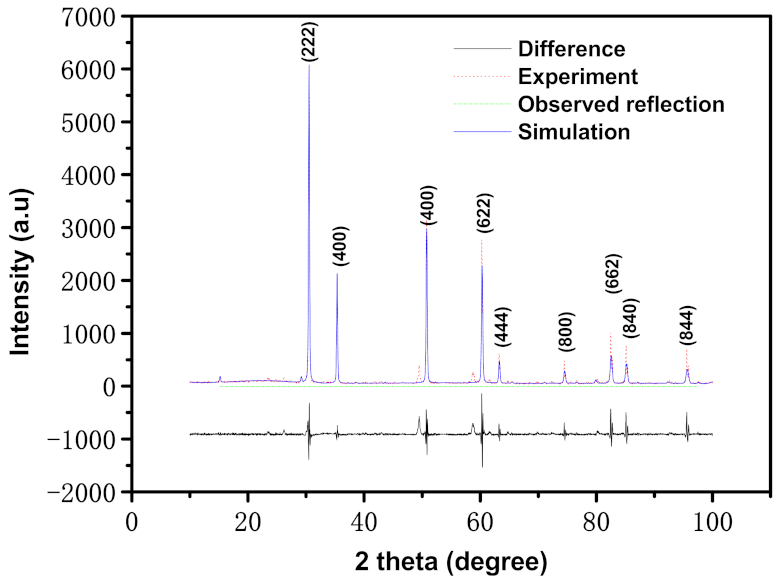
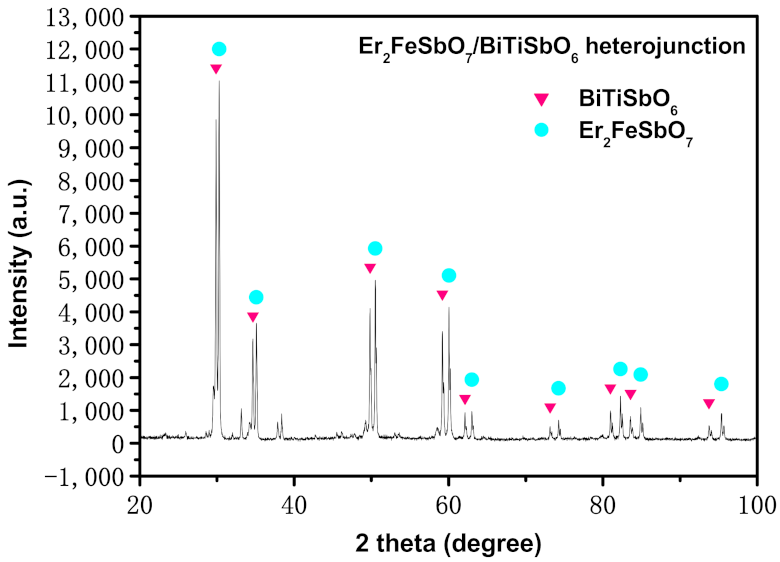
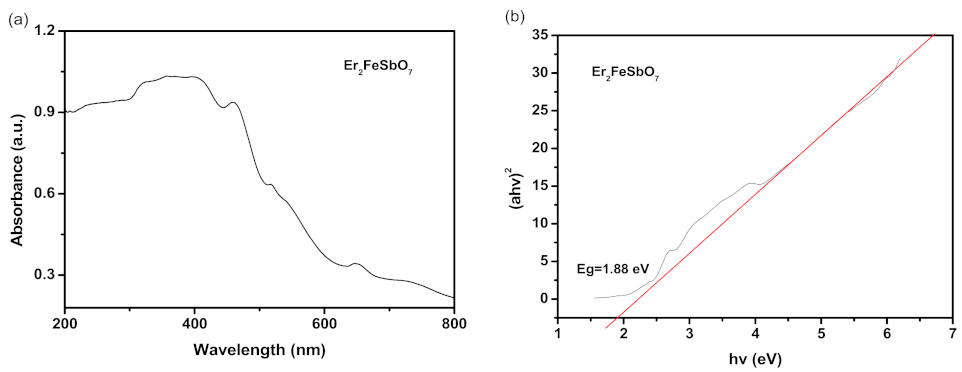
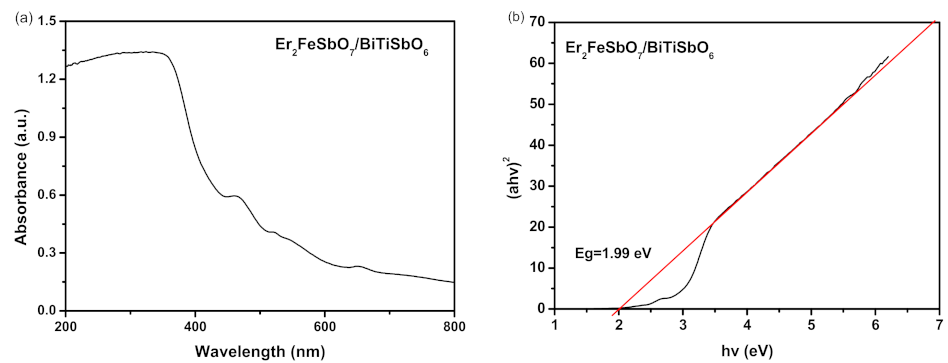
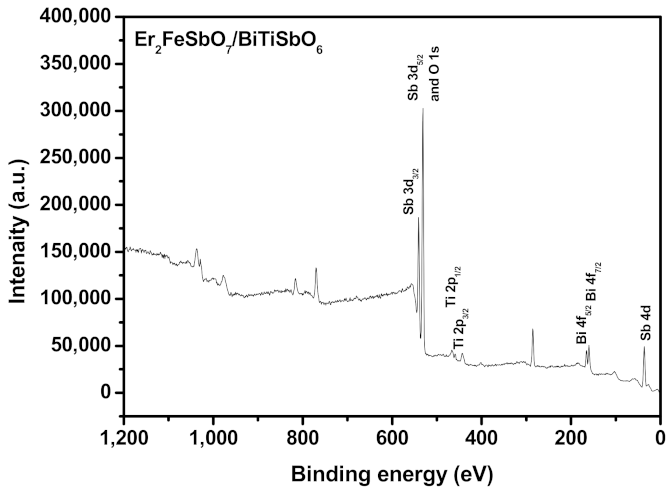
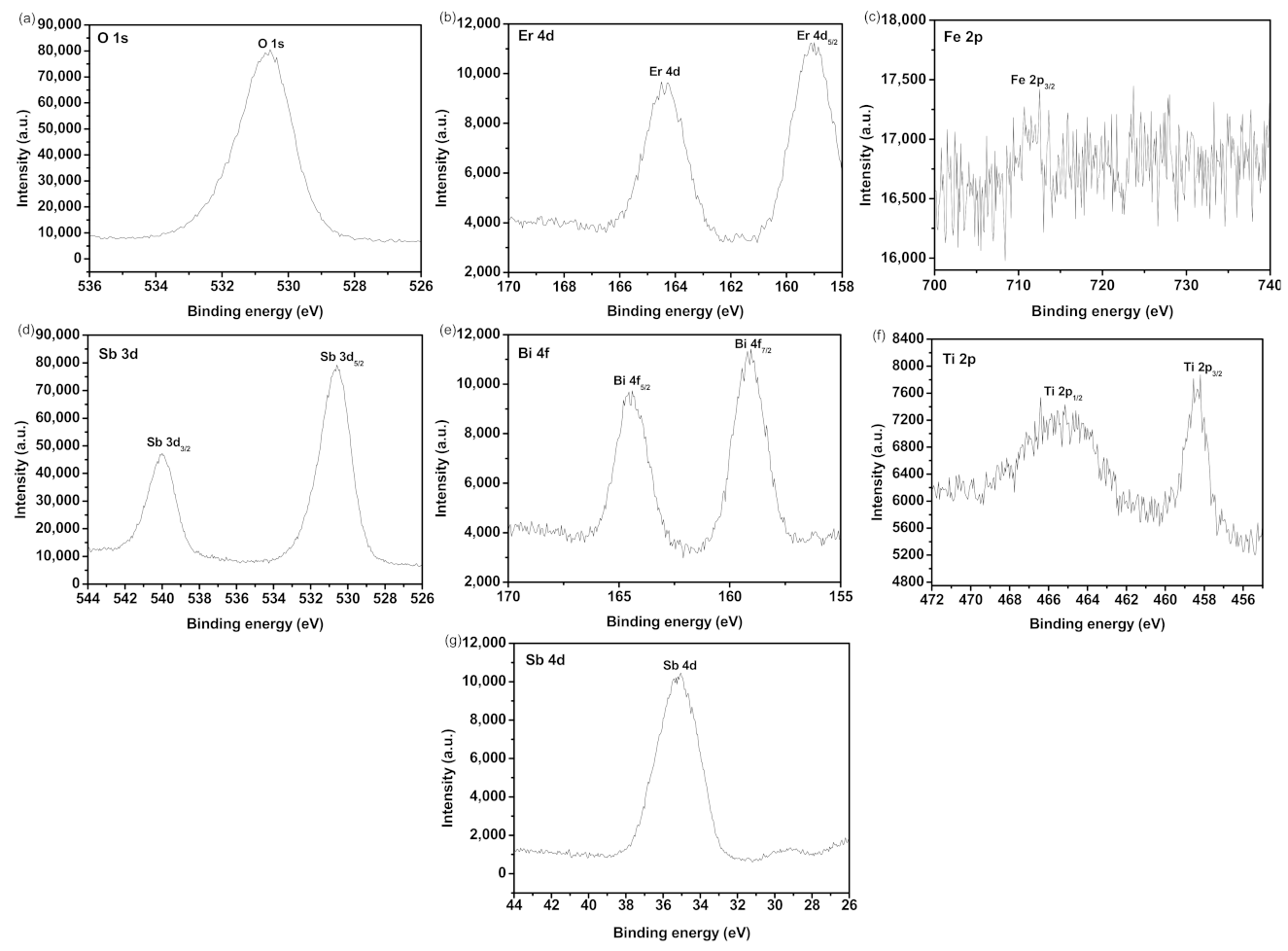
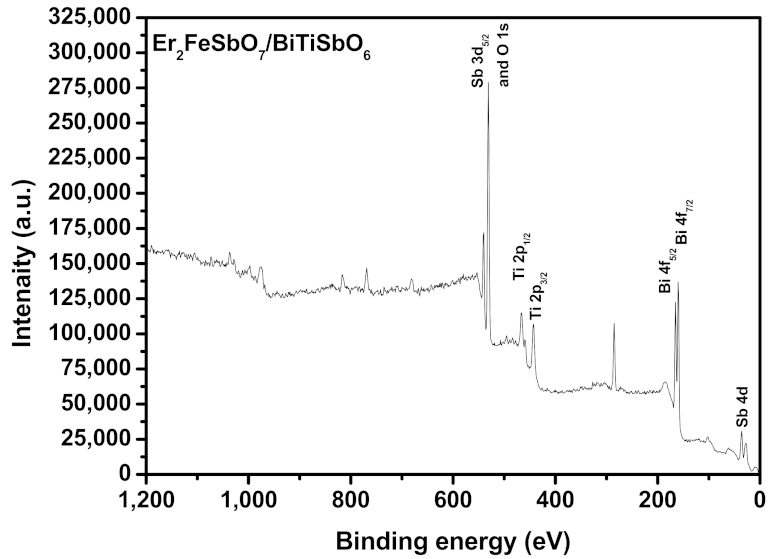
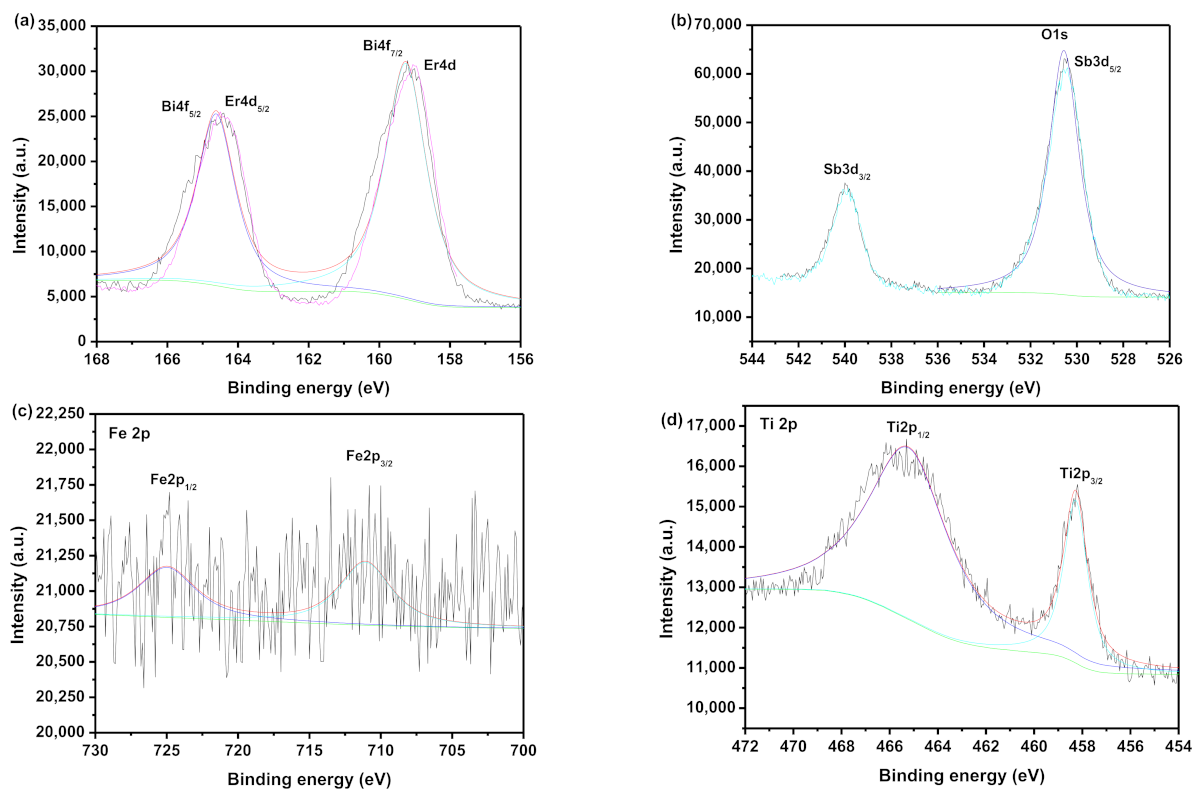
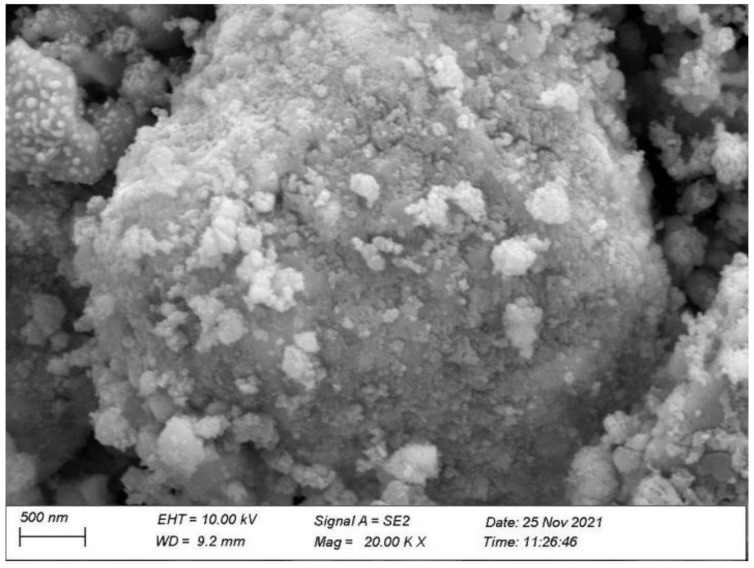
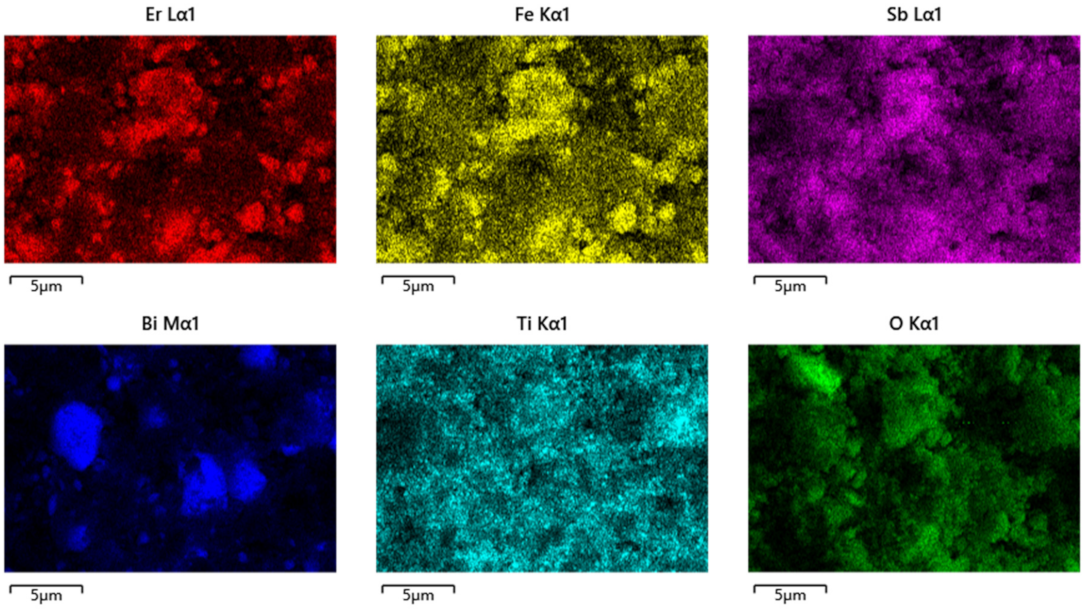

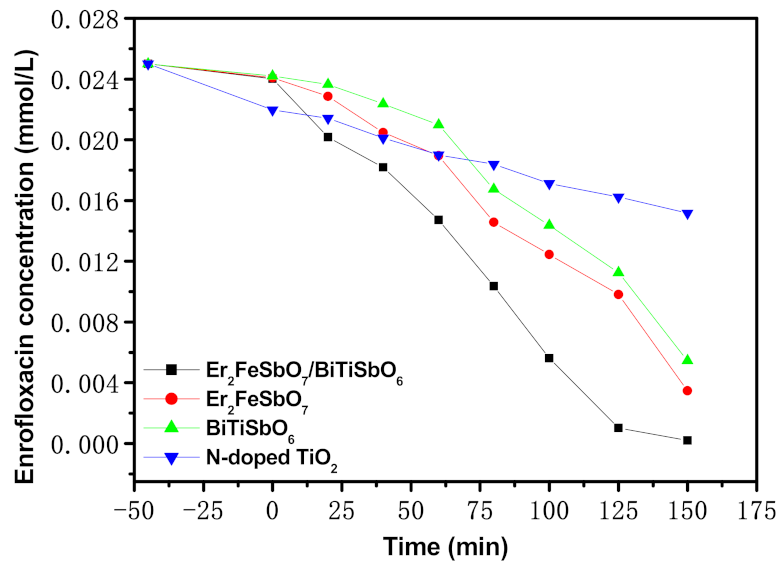
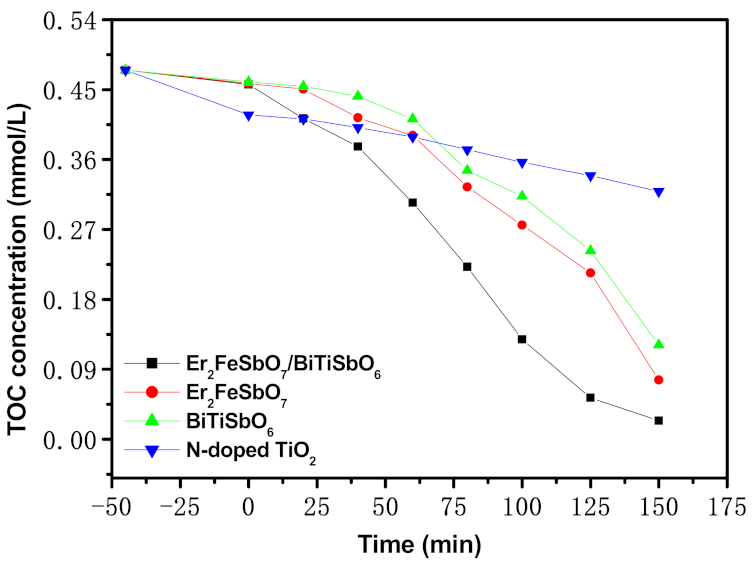
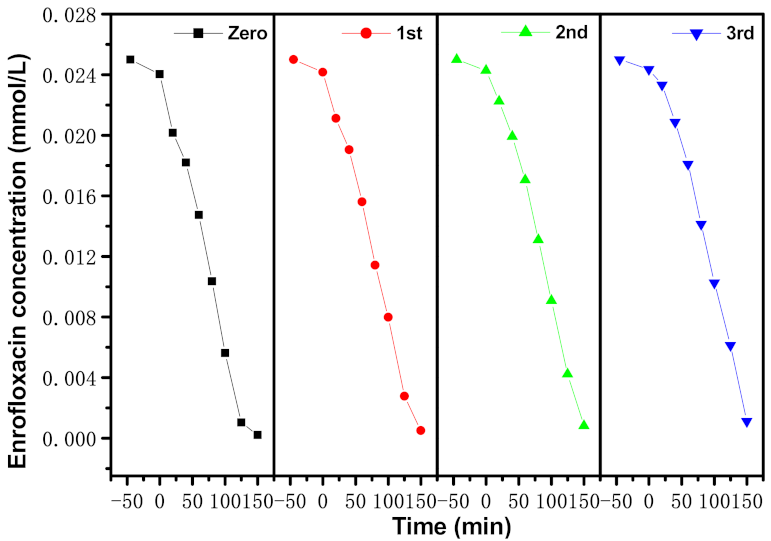
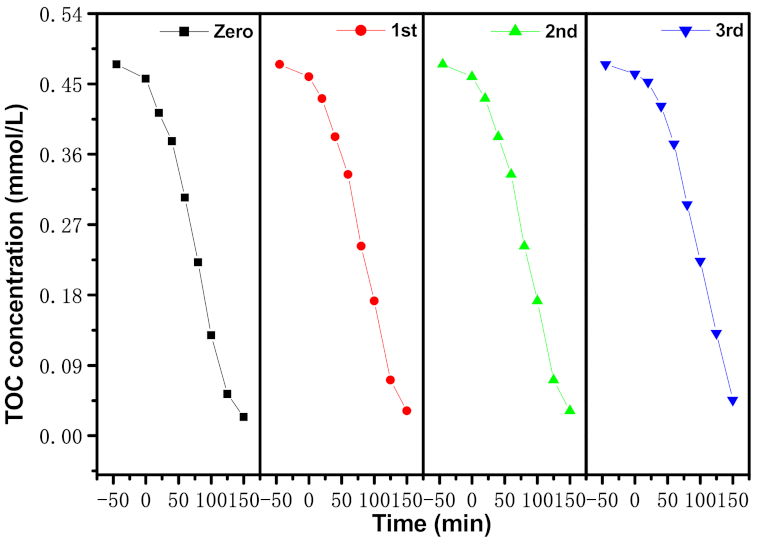
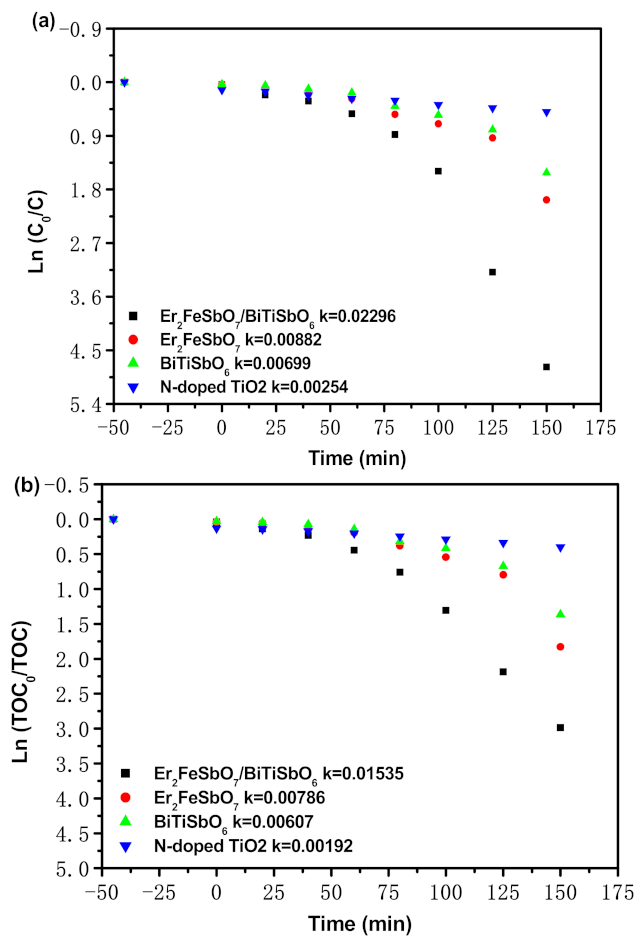
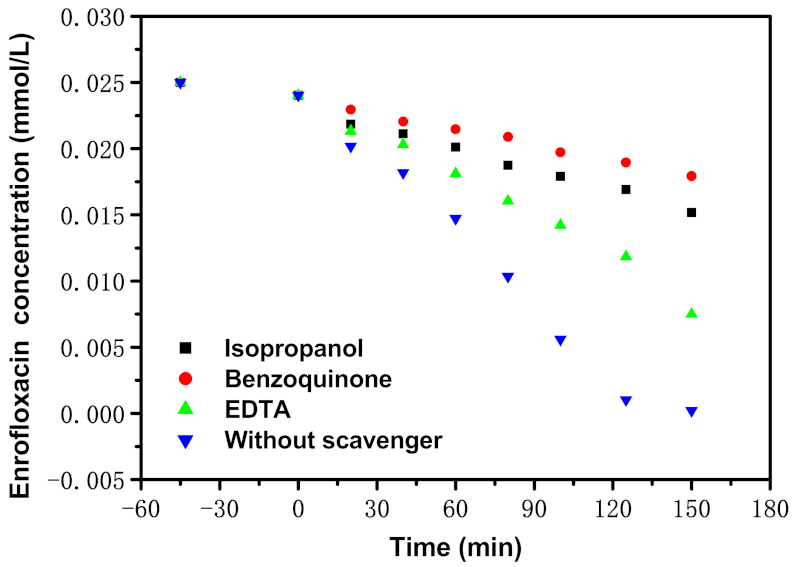
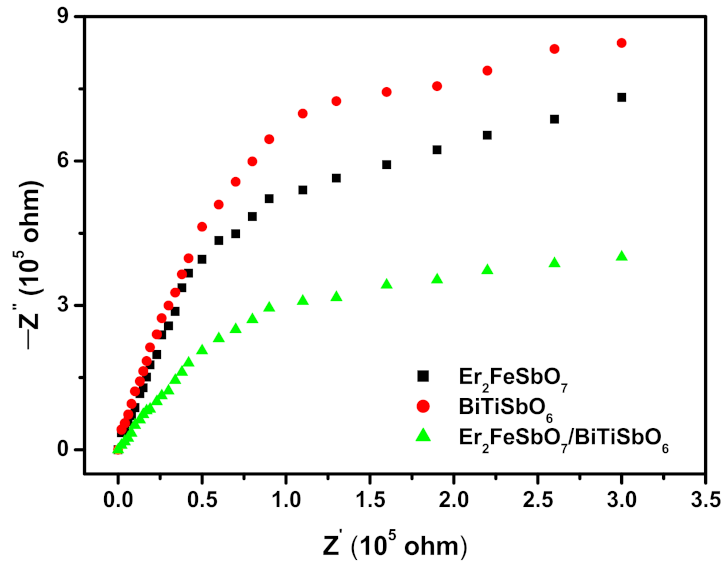
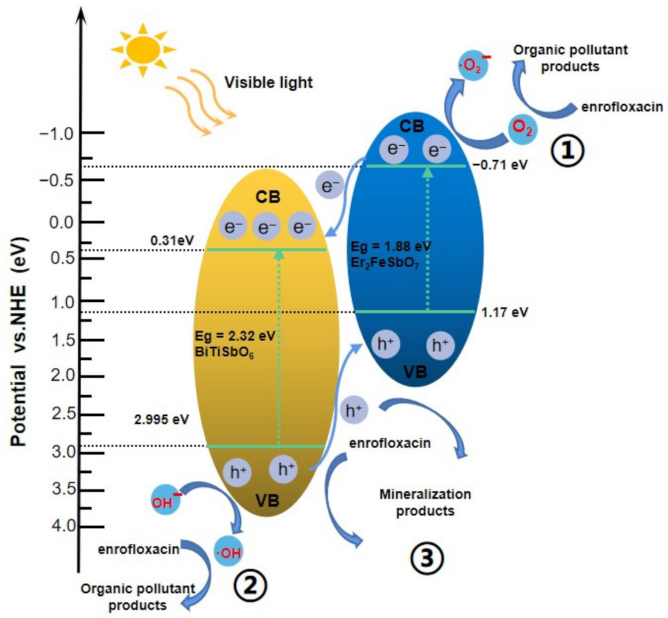
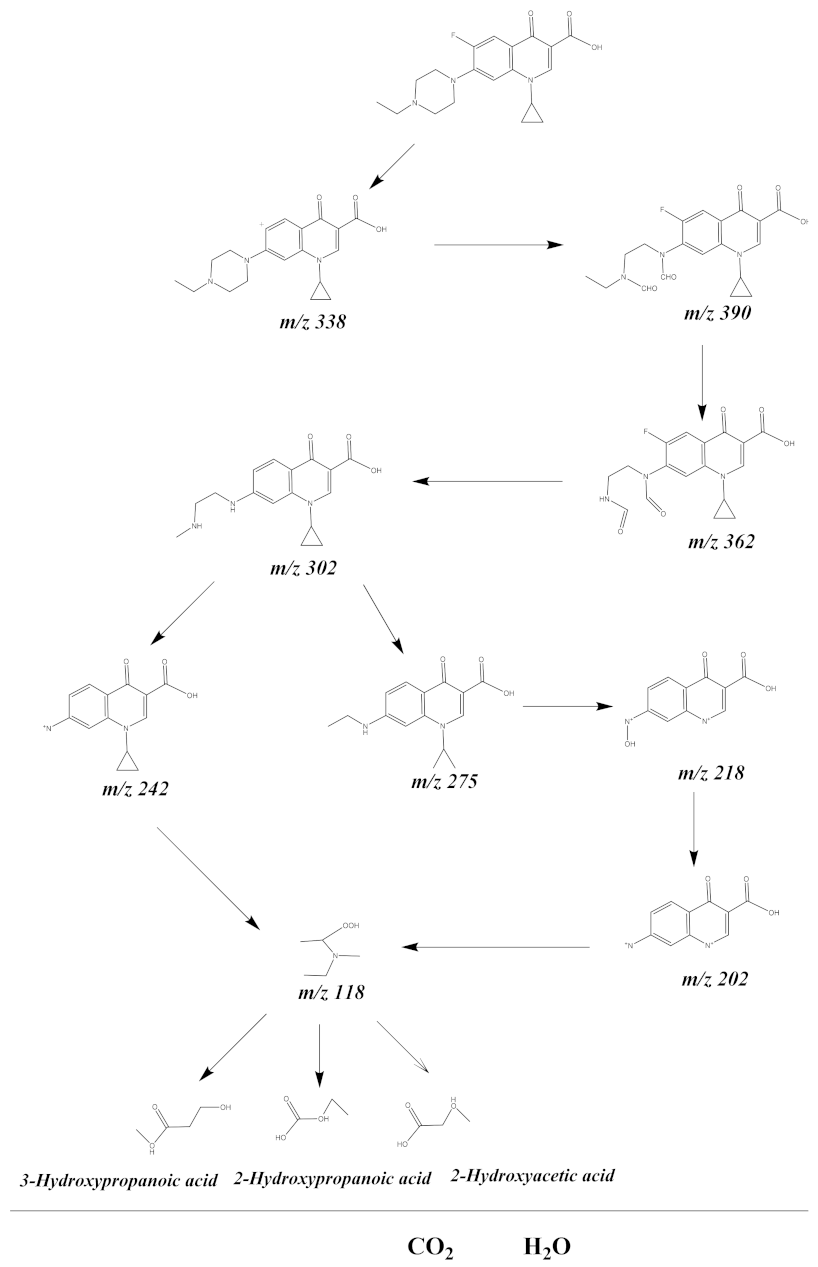
| Atom | x | y | z | Occupation Factor |
|---|---|---|---|---|
| Er | 0 | 0 | 0 | 1 |
| Fe | 0.5 | 0.5 | 0.5 | 0.5 |
| Sb | 0.5 | 0.5 | 0.5 | 0.5 |
| O(1) | −0.185 | 0.125 | 0.125 | 1 |
| O(2) | 0.125 | 0.125 | 0.125 | 1 |
Publisher’s Note: MDPI stays neutral with regard to jurisdictional claims in published maps and institutional affiliations. |
© 2022 by the authors. Licensee MDPI, Basel, Switzerland. This article is an open access article distributed under the terms and conditions of the Creative Commons Attribution (CC BY) license (https://creativecommons.org/licenses/by/4.0/).
Share and Cite
Luan, J.; Liu, W.; Yao, Y.; Ma, B.; Niu, B.; Yang, G.; Wei, Z. Synthesis and Property Examination of Er2FeSbO7/BiTiSbO6 Heterojunction Composite Catalyst and Light-Catalyzed Retrogradation of Enrofloxacin in Pharmaceutical Waste Water under Visible Light Irradiation. Materials 2022, 15, 5906. https://doi.org/10.3390/ma15175906
Luan J, Liu W, Yao Y, Ma B, Niu B, Yang G, Wei Z. Synthesis and Property Examination of Er2FeSbO7/BiTiSbO6 Heterojunction Composite Catalyst and Light-Catalyzed Retrogradation of Enrofloxacin in Pharmaceutical Waste Water under Visible Light Irradiation. Materials. 2022; 15(17):5906. https://doi.org/10.3390/ma15175906
Chicago/Turabian StyleLuan, Jingfei, Wenlu Liu, Ye Yao, Bingbing Ma, Bowen Niu, Guangmin Yang, and Zhijie Wei. 2022. "Synthesis and Property Examination of Er2FeSbO7/BiTiSbO6 Heterojunction Composite Catalyst and Light-Catalyzed Retrogradation of Enrofloxacin in Pharmaceutical Waste Water under Visible Light Irradiation" Materials 15, no. 17: 5906. https://doi.org/10.3390/ma15175906
APA StyleLuan, J., Liu, W., Yao, Y., Ma, B., Niu, B., Yang, G., & Wei, Z. (2022). Synthesis and Property Examination of Er2FeSbO7/BiTiSbO6 Heterojunction Composite Catalyst and Light-Catalyzed Retrogradation of Enrofloxacin in Pharmaceutical Waste Water under Visible Light Irradiation. Materials, 15(17), 5906. https://doi.org/10.3390/ma15175906








